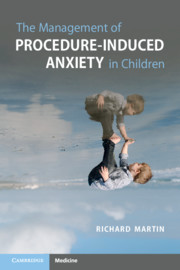
- Publisher:
- Cambridge University Press
- Online publication date:
- May 2021
- Print publication year:
- 2021
- Online ISBN:
- 9781108913317
Last updated 27/06/24: Online ordering is currently unavailable due to technical issues. We apologise for any delays responding to customers while we resolve this. For further updates please visit our website: https://www.cambridge.org/news-and-insights/technical-incident


Procedure induced anxiety affects the majority of children undergoing medical intervention and has been directly linked to behaviour disturbances, psychological trauma, phobias and symptoms of PTSD. Despite this, there is currently no formal training relating to the management of procedure induced anxiety for medical personnel caring for children. A distillation of more than eighty years of research, this textbook examines the nature, prevalence and consequences of anxiety in children, alongside evidence-based strategies for its effective management. Designed as a training manual, it includes a comprehensive account of positive and negative aspects of behaviour that contribute to the successful management of anxious children. Chapters cover topics such as non-verbal and verbal communication, enhanced communication management strategies, support of children with autistic spectrum disorder, ADHD, learning difficulties, the use of premedication and the role that families play. Essential reading for anaesthetists and paediatricians and a valuable resource for any practitioner working with children.
‘Educational and enlightening, this book is like turning a light on with regards to how children feel and behave when they get anxious and stressed. All healthcare professionals will find it incredibly useful for understanding how the children actually feel and their response to fear caused by medical intervention and how this can develop into a major phobia. This book teaches us about behaviour and shows us how we can modify what we do and how we do it to positively influence the children we care for. The techniques and strategies described made me reconsider and change how I behave around both children in a healthcare setting and my own children. This is rare in a ‘textbook’ and I would urge anyone working with children throughout healthcare to read and treasure it.’
Andrew Klein - Consultant, Royal Papworth Hospital, Cambridge; Editor-in-Chief, Anaesthesia; Macintosh Professor, Royal College of Anaesthetists, London
‘This is one of the most interesting factual books I have read for a very long time.Richard Martin shows that the recognition by the operative team makes an enormous difference to the child's experience before, during, immediately after surgery and also in the weeks following surgery. This book is summed up beautifully by a subheading that is labelled ‘we all communicate’. It demonstrates that communication is the key to both understanding and improving a child's procedure induced anxiety. This book should be part of the core curriculum for doctors or other providers in anesthesia, surgery and nursing. In years to come it will be considered a game-changer with respect to how healthcare providers view and understand procedure induced anxiety in children’
Ken K. Nischal - M.D, FAAP, FRCOphth; Division Chief, Pediatric Ophthalmology and Strabismus; Medical Director, Digital Medicine, UPMC Children’s Hospital of Pittsburgh; Professor, University of Pittsburgh, School of Medicine
‘This book offers invaluable guidance to all healthcare workers involved in the care of children who might be undergoing anxiety inducing procedures. The author draws on his extensive experience to provide readers with strategies to help reduce anxiety in children and young people, and also help them to develop coping strategies to manage their anxiety. This knowledge should form part of the core skills that everyone should have who is involved in the care of children.’
‘This book is unique because it presents expert clinical information, yet it does not limit the readers background to physicians or advanced practitioners, making it applicable to a broader audience.’
Luis Salcedo Source: Doody's Notes
‘… The book is well organized, with sections numbered for easy reference. The information throughout is detailed and technical. While these aspects are helpful, they contribute to the book reading like an encyclopedia. Dr Martin describes interactions in a mechanistic way, and there are no cases described to pull the reader into the importance of the topic at a more personal level, … this book serves as a good reference volume.’
Elizabeth C. Halloran Source: Family Medicine Journal
 Loading metrics...
Loading metrics...
* Views captured on Cambridge Core between #date#. This data will be updated every 24 hours.
Usage data cannot currently be displayed.